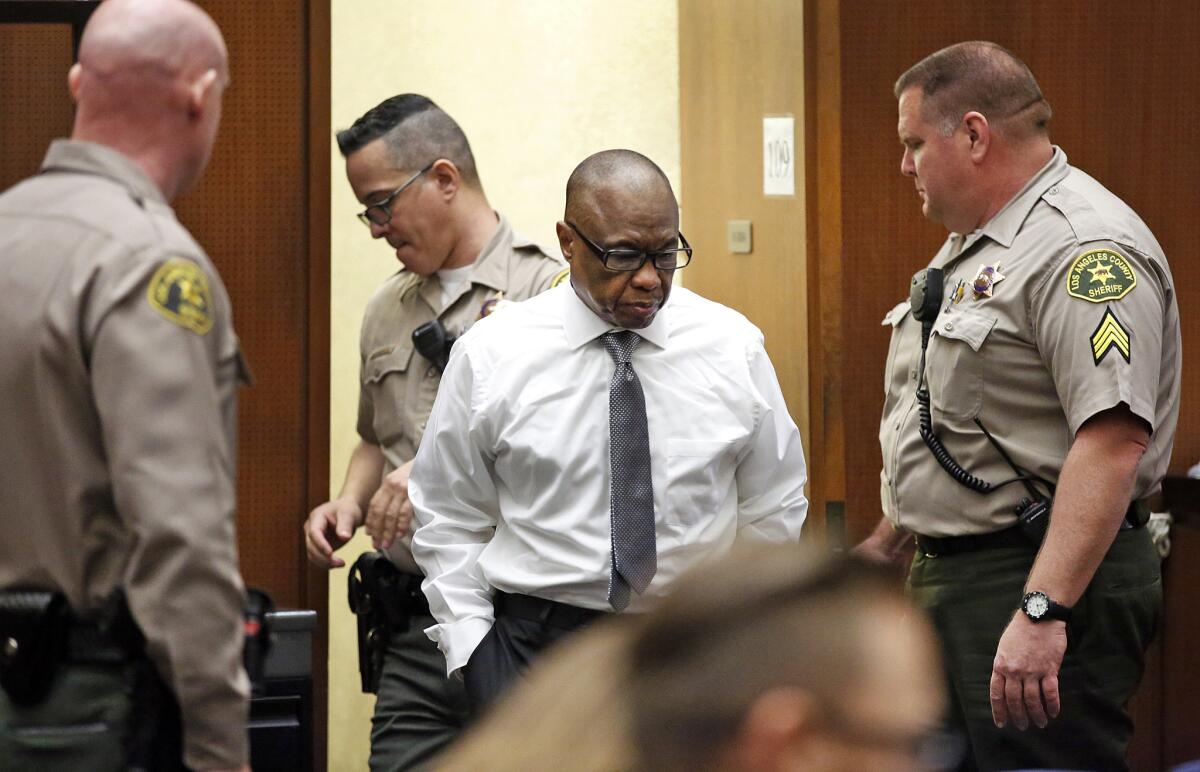Expert witnesses in Grim Sleeper trial spar over ballistics evidence

Lonnie Franklin Jr. enters the courtroom early in his murder trial. Franklin is charged with the so-called Grim Sleeper killings that terrorized South L.A. over more than two decades.
Two expert witnesses in the trial of the alleged Grim Sleeper serial killer faced off this week, one attempting to discredit key ballistics evidence in the case as unreliable and the other insisting that the methods used are scientifically sound.
The defense raised questions about the ballistics analysis as testimony in the trial of Lonnie Franklin Jr., accused in a series of South Los Angeles slayings, nears its conclusion.
Franklin faces 10 counts of murder in the deaths of nine women and a 15-year-old girl, spanning more than 20 years. He also faces one count of attempted murder.
Franklin, 63, has pleaded not guilty.
Forensic evidence has emerged as a key factor in the trial, with prosecution witnesses attempting to connect Franklin to each of the 10 victims, as well as the 11th who survived, by DNA and ballistics matches.
Franklin’s DNA was found on the bodies or at the crime scenes of seven of the victims, according to evidence presented by prosecutors.
A gun found during a search of Franklin’s home was used to kill one of the victims, according to testimony. Police criminologists testified that bullets from seven of the victims — six who were killed and the one who survived — were fired from the same weapon. Of those victims, Franklin’s DNA was found on three.
But defense witness David LaMagna, a materials scientist who says he works as a forensic investigator, in his testimony dismissed the methods used by criminalists in the case as insufficient.
He said, for example, that identifying bullets by comparing toolmarks left by a gun’s barrel is not enough to ensure a true match. Authorities currently use 2-D comparison microscopes to identify unique marks left on the bullets, while they should use more advanced techniques involving 3D mapping technology and electron microscopes, he said.
The methods used in the case have never been subject to proper scientific scrutiny and are highly subjective, LaMagna said.
“It’s generally an overstatement of what they can prove,” he said.
But under sharp questioning by Deputy Dist. Atty. Beth Silverman, LaMagna said he has never used the techniques he recommends because of their high cost and could not name any peer-reviewed studies that validate their use in forensic science.
LaMagna acknowledged that he did not conduct a full analysis of the evidence in the case. And he said that the report he prepared, based on his review of testimony from the criminalists who conducted the analyses, includes inaccuracies because he was under pressure to meet court deadlines.
Silverman took aim at LaMagna’s educational background, which he said did not include training in firearm toolmark analysis or microscopy.
LaMagna was also asked about other areas of criminal investigation listed on his resume and website, including work in crime scene investigation and reconstruction, homicide investigations and as a medical investigator.
Under questioning, LaMagna said he had never conducted any active crime scene investigations but has worked as a defense investigator in the past.
“Is this intended to mislead people to think you are more qualified than you actually are?,” Silverman asked.
“No, not at all,” he said.
The defense rested its case after LaMagna’s testimony.
On Thursday, the prosecution’s rebuttal witness James Hamby, director of the Indianapolis-Marion County Forensic Services Agency, defended DNA and ballistics analyses used in the trial as scientifically sound and widely accepted.
LaMagna’s examination, report and notes on the case evidence would not be acceptable in any accredited forensic lab in the country, Hamby claimed.
Hamby also asserted that the methods LaMagna discredited have passed through decades of extensive peer-review that show the practices are reliable and accurate.
The methods espoused by LaMagna, he said, have not undergone such scrutiny and should not be used in forensic testing until they have been properly tested.
Cross-examination is scheduled to continue Friday.
For more on the Grim Sleeper trial, follow @sjceasar
ALSO
Drunk driving suspect killed after short pursuit with LAPD
Wind-driven brush fire forces evacuation of drug treatment center in Ventura
Father and two sons shot to death in South Sacramento home invasion robbery
More to Read
Start your day right
Sign up for Essential California for news, features and recommendations from the L.A. Times and beyond in your inbox six days a week.
You may occasionally receive promotional content from the Los Angeles Times.







